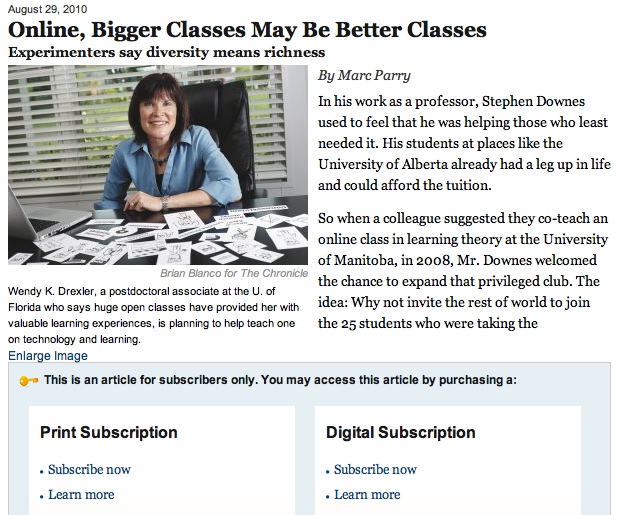Stephen Downes observed that the response from elite institutions to MOOCs has been essentially instantaneous – and unprecedented in both immediacy and scale of the response.
That entire post is great, as is the rest of his coverage of the EDUCAUSE MOOC conference.
The money shot, on response to MOOCs:
MOOCs were not designed to serve the missions of the elite colleges and universities. They were designed to undermine them, and make those missions obsolete.
Yes there has been a great rebranding and co-option of the concept of the MOOC over the last couple of years. The near-instant response from the elites, almost unprecedented in my experience, is a recognition of the deeply subversive intent and design of the original MOOCs (which they would like very much to erase from history).
So, how does the institutional response to MOOCs compare to other educational technology and/or pedagogical advancements? How many of the following innovations/initiatives have drawn a similarly-scaled response from institutions, warranting millions of dollars and thousands of man-hours devoted to their pursuit?
- Learning Objects (and Learning Object Repositories)
- Web 2.0
- Open Education Resources
- Individual publishing platforms (blogging etc…)
- Collaborative publishing platforms (wikis etc…)
- Badges and open credentials
- Cable TV in the Classroom
- etc…
Those things, and many others, never really bubbled above the level of “let’s present something at a conference and wonder why nobody understands how awesome this stuff is!” (admittedly, some of it turned out to be less-than-awesome, but there hasn’t been the level of critique and introspection by institutions pushing MOOCs). Yes, some of those ideas took off on some scale, but none had anywhere near the level of frenzied institutional mouth-foaming enthusiasm – support was largely on the level of small projects or individual instructors, rather than Presidential Committees and Senatorial Task Forces.
Why are MOOCs different?
It’s not the technology – despite elite institutions building custom platforms to enable their vision of MOOCishness, the tools have been here for years.
It’s not the availability or ease of access to content. Open Education Resources, open textbooks, Creative Commons, wikibooks, etc… have been available for years. They’ve been useful and interesting, but haven’t gained anywhere near a sizeable fraction of the attention that MOOCs have attracted.
I think Stephen nailed it – MOOCs have gone big because institutions see the subversive power of them, and need to control the genie before it’s fully let out of the bottle. Maybe, through creative and selective cultivation, the genie can be defused, or the bottle recast, to eliminate the threat to the status quo, or at least to allow the elite institutions to maintain their position at the top of the food chain.
While many innovations have had at least the potential to disrupt the practices of education, MOOCs are the first (or at least the biggest) innovation to challenge the business of education. Follow the money.
Update: shortly after I hit “Publish”, I checked my RSS feeds and see this post by that jerkface @dkernohan, who lays it out with much more intelligence and depth than I have at my disposal.



